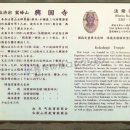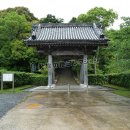「径山寺味噌」「醤油」の わが国 発祥之地
きんざんじみそしょうゆのわがくにはっしょうのち
紀勢本線 紀伊由良駅から県道23号 御坊湯浅線で北へ800m、興国寺の山門脇に興国寺の説明板が立っている。
中国の
写真
碑文
臨済宗 鷲峰山 興国寺
本寺は
葛山 五郎影倫 (願性)が鎌倉三代将軍源実朝の菩提を弔うため、安貞元年(1227)真言宗「西方寺」として建立された。
正嘉2年(1258)心地覚心(法燈 国師)が宗旨を禅宗に改めると、「関南第一禅林」として栄え、多くの高名な僧を輩出した。
覚心は永仁6年(1298)示寂、その後国師号を授かり、興国元年(1340)には後村上天皇から興国寺号を賜ったと伝えられる。
天正13年(1585)羽柴秀吉の紀州攻めで堂塔の大半を失ったが、紀州藩浅野家・徳川家代々の藩主の庇護のもと復興された。
他に普化尺八の本寺、「径山 寺味噌」「醤油」の わが国発祥之地として知られている。(略)
平成5年3月
由良町教育委員会
和歌山県教育委員会Kokokuji Temple
This temple was founded in 1227 by Katsurayama no Goro Kagetomo, whose religious name was Gansho Shonin, to assure the repose of the soul of Minamoto no Sanetomo, the third Kamakura Shogun. Originally the temple was called Saihoji and belonged to the Shingon sect of Buddhism. In 1258 Kagetomo invited Shinchi Kakushin to become the temple's head priest. Kakushin changed the temple's sect affiliation, switching from the Shingon to Riunzai sect of Zen. Kakushin died in 1298 and after his death was given the honorable title "Kokushi". In 1340 Emperor Gomurakami honored the temple itself with the new name of "Kokokuji". In 1585 Hashiba Hideyoshi's army attacked Kishū (now Wakayama), burning most of Kokokuji's buildings to the groundm, Later, under the patronage of the Daimyo (lord) of the Asanos and the Tokugawas, the buildings were reconstructed.
It may be noted the Kokokuji, is the birthplace of the custom among Zen Buddhists of wearing bamboo baskets over their heads and playing shakuhachi, long certical flutes. The temple is also the place of origin of Kinzanji miso, a food made from soybeans, as well as shoyu, Japanese soy sauce.

